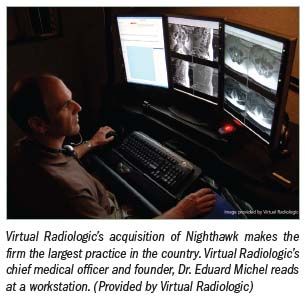Radiologists mixed on Virtual Radiologic/NightHawk merger
The Virtual Radiologic and NightHawk merger has some experts worrying about jobs, referral issues, a delays in care.
Radiologists have mixed feelings about the new merger between Virtual Radiologic and NightHawk. Opinions range from pleased because the new entity could be a potential partner to worry it will take away radiology jobs.
Privately held Virtual Radiologic announced Sept. 27 it will acquire NightHawk, a publicly traded national teleradiology practice, which makes Virtual Radiologic the largest radiology practice in the country.
The combined entity will have 325 radiologists serving nearly 2700 healthcare facilities across all 50 states and reading approximately six million studies annually. Additionally, more than 75% of the affiliated radiologists will be fellowship-trained subspecialists. The merger is set to be completed in the first quarter of 2011.
Virtual Radiologic’s move is an incredibly smart one because they not only bought out their largest competitor, they bought the name NightHawk, according to Dr. Lawrence Muroff, president and CEO of Imaging Consultants in Tampa, FL, and a longtime follower of radiology business.

In recent years “NightHawk” has become synonymous with “teleradiology,” so much so that when people refer to “nighthawking,” often they’re not referring to the company.
“If you were a manufacturer of tissues and you had the opportunity to buy Kleenex, which is synonymous in people’s minds with tissue, wouldn’t you do it?,” he said. “I think it was a very smart move and one I would have made in Virtual Radiologic’s position.”
Repercussions of the move remain to be seen, but most likely not much will change in the day-to-day radiology world, said Dr. Howard Forman, a professor of diagnostic radiology and epidemiology and director of the M.D./MBA program at Yale University.
“It’s a consolidation in an industry that is still having a hard time proving where it adds value. Certainly [in terms of] economies of scale, they potentially have more to offer than they do as stand-alone entities,” he said. “But neither entity can prove it specifically adds value as opposed to just acting as a broker for radiology services.”
Whether the combined firms will have a competitive advantage is another question, he added.
“They are an enormous entity in terms of the teleradiology space, but they compete with thousands of other practices,” he said.
Other radiologists share Forman’s point of view.
“There is still a great deal of competition in this space, so I don’t see this merger as particularly harmful to the market or consumers,” Dr. Allen Elster, radiology chair at Wake Forest University Baptist Medical Center in Winston-Salem, NC. “I don’t fear this; it is simply reality.”
This merger may not mean nearly as much as people imagine it will, said Dr. Mark Klein, a radiologist at Washington Radiology Associates in the District of Columbia.
“First of all, many hospitals and clinicians are happy with their imaging situations,” he said. “They need interventionalists and mammographers onsite, and if the local radiologists are doing a good job, providing high-quality interpretations and timely service, there is little incentive right now for these institutions to change.”
Dissatisfied hospitals would eventually have made a change anyway; this is just another option, he said. Rob Kill, president and CEO of Virtual Radiologic, said the merger is no cause for alarm among the radiology community.
“The professional services market for radiology is $20 billion. Combined, Virtual Radiologic and NightHawk have slightly more than 1%, which is not a lot of concentration,” he said. “It’s a big market out there, so yes, obviously we’re a big player, but it’s a drop in the bucket of the overall market.”
Others are not so keen to believe the merger is nonthreatening. Dr. Stamatia Destounis, a radiologist at Elizabeth Wende Breast Care in Rochester, NY, said the merger could hurt radiologists.
“These huge acquisitions will take jobs from local radiologists, create issues for referring doctors, possibly create delays for the care of patients, and cause the local radiologists to review/reread these studies when the consulting doctors come to ask for advice or help with the original reads,” she said.
The merger could also harm the local community by taking money from local radiologists, and cause hardship for them if their volume and reimbursement decrease, she said.
While the new company may be a competitor for local radiologists, it’s also likely Virtual Radiologic/ NightHawk will act as a potential partner, according to Muroff.
“I think this company will be very capable of taking over hospital contracts. But it will also be capable of providing subspecialty expertise and night assistance for existing practices,” he said. “It could partner, it could compete. My guess is it will do both.”
Kill emphasized competing with local groups is not the company’s not. “In all cases, we want to partner as an invited guest to help them at their practice,” he said. “We’re not looking to compete with local radiology practices.”
Don’t panic and don’t sell into a falling market, is Klein’s advice to radiologists. Get better at everything: improve quality of interpretations, minimize radiation dose, optimize the level of service and timeliness of reports, and provide metrics, he said.
“If you can provide top-level care with proven safeguards and documentation of best practices, I would predict ongoing success, no matter how big Virtual Radiologic or other teleradiology groups grow,” he said.
The Reading Room: Artificial Intelligence: What RSNA 2020 Offered, and What 2021 Could Bring
December 5th 2020Nina Kottler, M.D., chief medical officer of AI at Radiology Partners, discusses, during RSNA 2020, what new developments the annual meeting provided about these technologies, sessions to access, and what to expect in the coming year.
Strategies to Reduce Disparities in Interventional Radiology Care
March 19th 2025In order to help address the geographic, racial, and socioeconomic barriers that limit patient access to interventional radiology (IR) care, these authors recommend a variety of measures ranging from increased patient and physician awareness of IR to mobile IR clinics and improved understanding of social determinants of health.